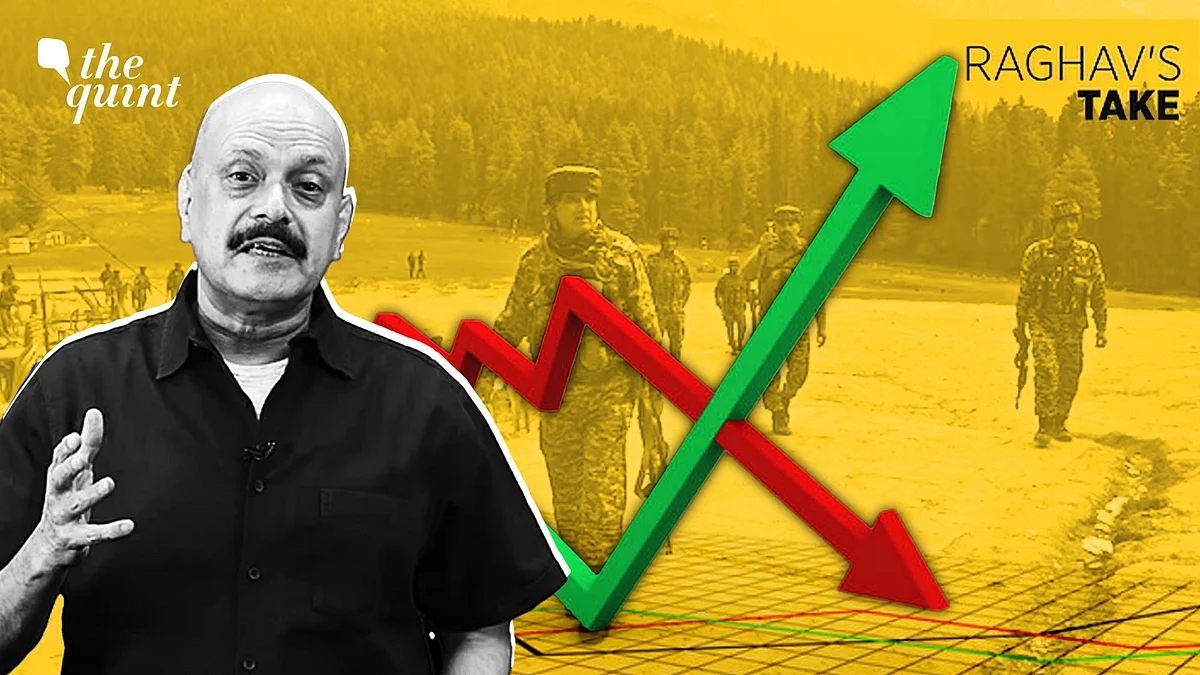War Scare, Market Flare: What Pahalgam Taught Investors Before Peace Returned
Would the principles of the “war boom” phenomenon apply to the aftermath of the Pahalgam War?

advertisement
Indian stock markets have been supremely confounding since Prime Minister Narendra Modi won a third term in June 2024 — for pundits and punters alike. Within a hundred days of his re-election, the markets had leapt over 15 percent, adding almost a trillion dollars (Rs 85 lakh crore!) in value. The rupee remained rock steady around 84 against the US dollar.
Just when every investor, including the proverbial paanwalah, got dizzyingly bullish, the markets swivelled sharply, falling over 15 percent in six months, between October 2024 and March 2025. The rupee plummeted by five percent to Rs 88/dollar, and foreign investors sold nearly $15 billion (Rs 1.2 lakh crore).
Now everybody, including paanwalahs, began predicting doom in typical bear language:
“Who will catch the falling knife?”
“There is no bottom in a bear market.”
“The rupee will slide past 90/dollar, and the goras (foreigners) will sell another Rs 1 lakh crore”.
When US President Donald Trump unveiled his astonishing retaliatory tariffs in early April—145 percent on China and 26 percent on India—the markets fell off a cliff. But, in India, it was a stunning bungee jump, because in a few surreal days, the rupee gained five percent, breaching Rs 84/dollar, and the markets recouped nearly half a trillion dollars in value.
Nobody—repeat nobody—had any clue, explanation, or prediction of this incredible yo-yo.
Straight From a Star Fund Manager’s Mouth
At Pessimism Peak in March, I was advised to sell mid-caps and move into large-caps. I was about to press the button when an alarmed fund manager—perhaps the best in the trade, whose portfolio returns have consistently stayed above 20 percent per annum over a decade—called and beseeched me to stay put. “Why?”, I asked.
Star Fund Manager: The market leap after Modi’s victory was sheer euphoria. Those bubble-like valuations had to blow up.
Me: Why in September 2024?
Star Fund Manager: Because foreign money pivoted towards China, where a stimulus yanked up stocks by over 20 percent in a week! And anticipating a Trump victory, along with a strong dollar, investors shovelled even more cash into American stocks. So, foreigners, who were sitting on fabulous profits in India, sold aggressively.
Me: But why are you confident that India will recover now?
Star Fund Manager: Several reasons.
One, government spending, which had slowed down because of Haryana and Maharashtra polls, is picking up swiftly now.
Two, rural demand is showing an uptick.
Three, corporate earnings have bottomed out, and should start spiking now.
Four, Trump’s tariffs have made China a touch-me-not.
Five, Trump is tearing down our tariff walls, and less protection will be good for efficiency.
Six, Trump is all for a weaker dollar, so a stronger rupee will make Indian paper even more attractive.
Seven, we are one of the few countries in the world, which is cutting interest rates, given benign inflation, so equities will get a natural boost.
As he finished his spiel, both of us were silent for almost half a minute. Then suddenly, we blurted out together: “But all bets are off with this Pahalgam War.”
The “War Boom” Phenomenon
What the Second World War (WWII) did to American stocks is an overarching—the most indisputable—case study. American markets lost nearly 90 percent of their value between 1929 and 1933 during the Great Depression. Nearly 15 million—or a quarter of the workforce—were unemployed. Over 9,000 banks failed. GDP shrank by 30 percent. If ever an economy went through hell, this was it.
Ironically, Uncle Sam was running a small budget surplus during some years in the 1930s. But the beginning of hostilities gave an involuntary Keynesian “shock.” The American budget deficit spiralled by 3600 percent to over $50 billion between 1939 and 1943. Through the six-year war, the US government debt quintupled to $258 billion by 1945. The debt-to-GDP ratio peaked at 120 percent.
The Dow, which had fallen to 41.22 points in 1932, surged as soon as Pearl Harbor was attacked—it crossed the 150-point mark in 1941. It was a textbook illustration of what’s called the “war boom” phenomenon.
What Happened After Kargil, Uri, and Pulwama/Balakot?
Mercifully, the Pahalgam War will be nowhere near a world war. Equally mercifully, the Indian economy is nowhere near as ravaged as America was in the Great Depression. So, would the principles of the “war boom” phenomenon apply to the aftermath of the Pahalgam War, as and when it was to happen?
The rupee took a marginal dent, from Rs 43-44 to Rs 45-46 per dollar. But it too jumped right back to parity in July, in fact strengthened a tad, to Rs 42-43 per dollar. Inflation, interest rates, oil prices, gold prices, GDP growth rates—all moot variables stayed steady and on course, as if the Kargil War had not happened.
For whatever it’s worth, the Kargil pattern was cloned by the markets after the Uri surgical strikes in 2016, and the post-Pulwama Balakot missile attack in 2019. QED. Twice can be a coincidence, but thrice is a “forecastable model.”
With the standard stock market caveat that “past performance is not a guarantee of similar future outcomes,” I guess it would be safe to predict that the Pahalgam War could trigger a shallow, short-term dip in the stock and currency markets.